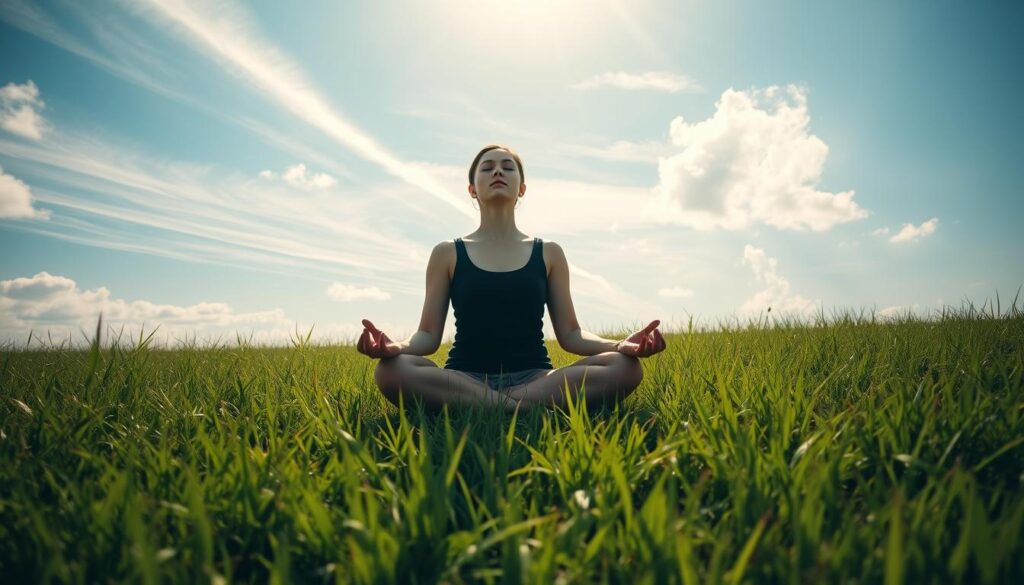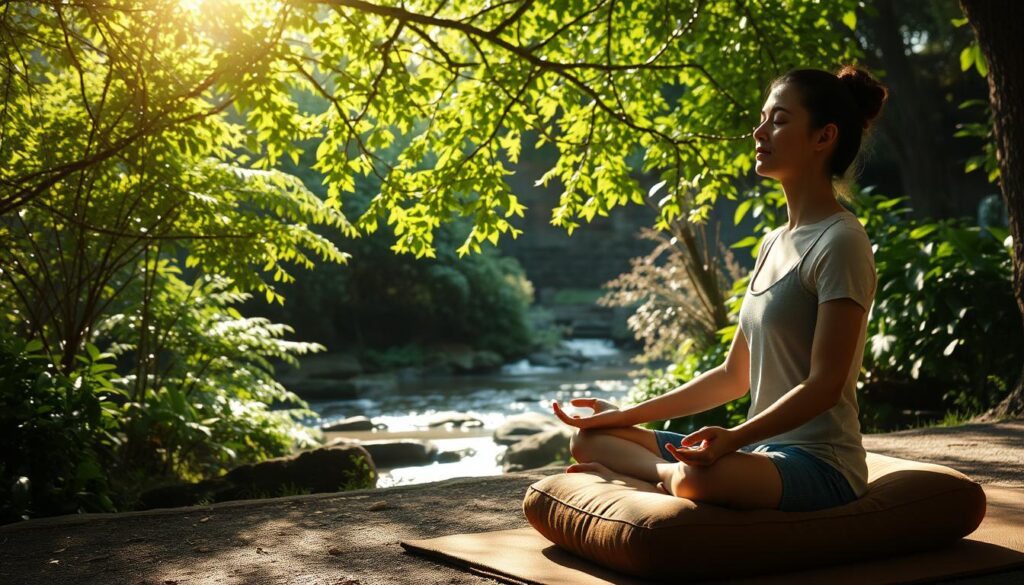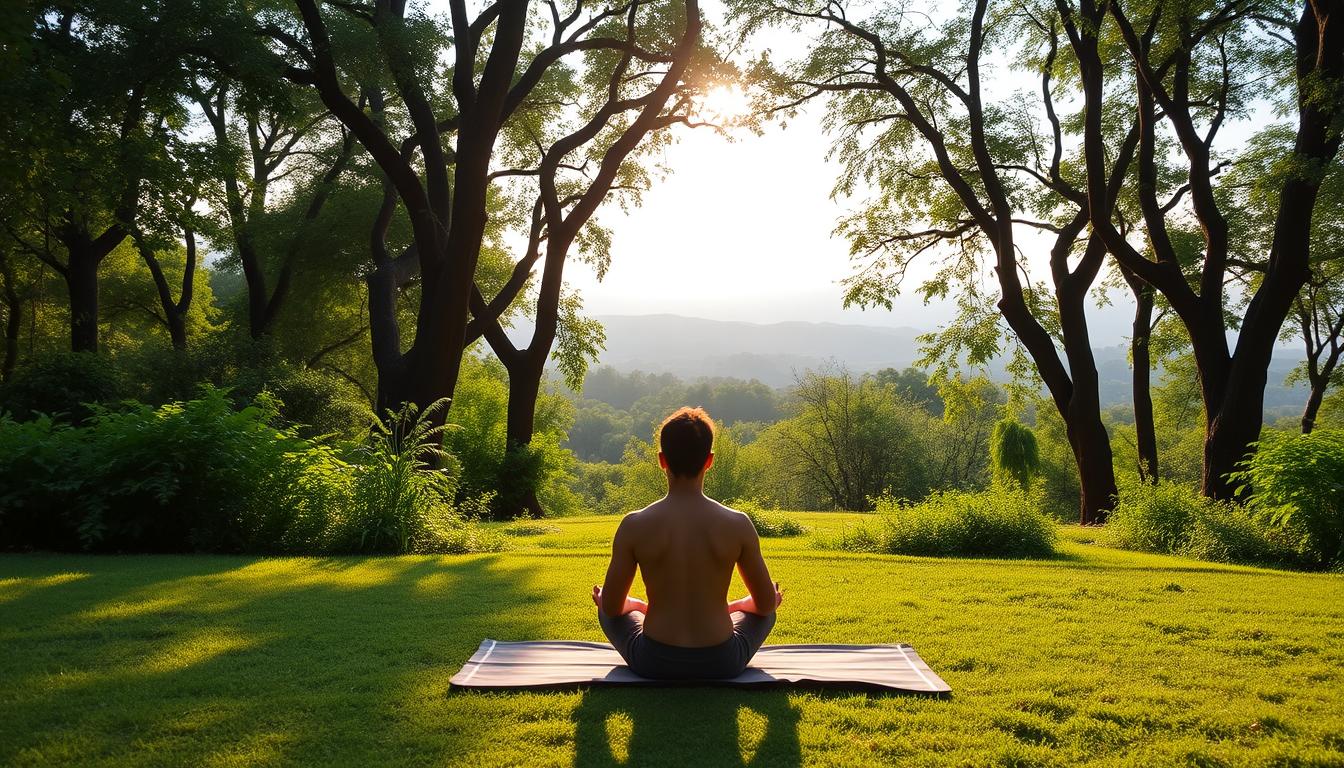In today’s fast-paced world, finding a moment of calm can seem like a luxury. Yet, meditation offers a simple way to pause, breathe, and reconnect with ourselves amidst the chaos. I’ve discovered that incorporating mindfulness into daily life can have a profound impact on both mental and emotional well-being.
Learning to meditate doesn’t require special equipment or hours of your day. It’s about focusing your attention, often through your breath, to cultivate a sense of calm and clarity. For beginners, starting with short, manageable sessions can make the practice feel less daunting and more enjoyable.
The beauty of meditation lies in its accessibility and the numerous benefits it offers, from reducing stress to improving focus. By making meditation a part of your daily routine, you can experience these benefits firsthand.
Key Takeaways
- Start with short meditation sessions to build a sustainable habit.
- Focus on your breath to cultivate mindfulness and calm.
- Meditation can reduce stress and improve your focus.
- It’s a practice accessible to anyone, regardless of their experience level.
- Regular meditation can lead to improved emotional well-being.
Understanding Meditation: What It Is and Why It Matters
As we dive into the world of meditation, it’s essential to understand its core principles and benefits. Meditation is a simple yet powerful practice that has been gaining popularity worldwide due to its numerous health benefits.
Defining Meditation in Simple Terms
Meditation, in simple terms, is a practice that helps you achieve a state of deep relaxation and mental clarity. It involves focusing your mind on a particular object, thought, or activity to achieve this state. Regular meditation practice can have a significant impact on both your physical and mental health.
The Science-Backed Benefits of Regular Practice
Research has consistently shown that regular meditation practice can have numerous benefits, including reducing stress and anxiety, improving sleep quality, and enhancing emotional regulation. Here are some key benefits:
- Reduce stress and anxiety by lowering cortisol levels
- Improve sleep quality
- Enhance emotional regulation
- Improve focus and concentration
Let’s take a closer look at some of the benefits of meditation in the table below:
| Benefits | Description |
|---|---|
| Reduce Stress | Lower cortisol levels, leading to a calmer state |
| Improve Sleep | Help fall asleep faster and enjoy deeper rest |
| Enhance Emotional Regulation | Respond to life’s challenges with greater equanimity |
The Easiest Way to Meditate: A Beginner’s Approach
Meditation doesn’t have to be complicated; in fact, the simplest way to meditate is often the most effective. As a beginner, you’re likely looking for a straightforward method to get started with your mindfulness journey.
Finding Your Comfortable Space and Position
The first step in meditating is to identify a comfortable and quiet space where you can sit without distractions. You can choose to sit on a chair, on a cushion on the floor, or even on your bed, depending on what feels most relaxing for you. The key is to maintain a posture that allows you to relax and focus on your breath without strain.
Setting Realistic Time Expectations
As a beginner, it’s essential to set realistic expectations about the time you’ll dedicate to meditation. Starting with short sessions, even just a few minutes a day, can be incredibly beneficial. As you become more comfortable with the practice, you can gradually increase the duration. The goal is to make meditation a sustainable habit.
The Simple Breath Focus Technique
The breath focus technique is arguably one of the most accessible meditation methods for beginners. It involves directing your attention to the physical sensations associated with breathing, such as the feeling of air moving through your nostrils or your chest rising and falling. When your mind wanders—a common occurrence, even among experienced meditators—gently acknowledge the distraction and return your attention to your breath. This practice is at the heart of mindfulness meditation, helping to strengthen your mental focus and cultivate a greater sense of awareness.

To practice this technique, simply focus on the sensation of your breath as it goes in and out. When you notice your mind wandering, gently bring your attention back to your breath without judgment. This simple yet powerful practice is the core of meditation, helping to build the muscles of attention and mindfulness.
By incorporating this simple breath focus technique into your daily routine, you’ll be taking the first step towards a more mindful and focused you. Remember, the journey to mindfulness is a personal and ongoing process, and every moment you dedicate to meditation is a step in the right direction.
Step-by-Step Meditation Guide for Beginners
In this section, we will walk you through a step-by-step guide on how to practice meditation. Practicing meditation can be broken down into simple, manageable steps.
Preparing Your Body and Mind
Begin by finding a comfortable position, either sitting or lying down, where you can relax without feeling too constrained or too relaxed. Take a few deep breaths, feeling the air fill your lungs and then leave them, and allow your body to start to relax.
As you get settled, take a moment to notice the sensation of your feet touching the ground, feeling grounded and connected.
Focusing on Your Breath
Close your eyes and bring your attention to your breath. Notice the sensation of the air entering and leaving your nostrils. Try to focus on the sensation of each breath without getting caught up in thoughts about it.
When you find your mind wandering, gently bring it back to the sensation of the breath.
Working with Wandering Thoughts
As you meditate, you will notice that your mind starts to wander. This is normal. When you catch your mind wandering, gently bring it back to your breath without any judgment. Do not try to force your mind to stay on the breath, but rather allow it to gently come back.
Ending Your Practice Mindfully
When you’re ready, gently lift your gaze. Take a moment and notice any sounds in the environment. Notice how your body feels right now. Notice your thoughts and emotions. It’s essential not to finish meditating too suddenly.
As you end your meditation practice, take a few moments to slowly come back to the present. Gradually expand your awareness from your breath to the sensations in your body, then to the sounds around you.
Here is a simple table to help you track your meditation practice:
| Step | Description | Time |
|---|---|---|
| Prepare | Get comfortable and relax | 2 minutes |
| Focus | Focus on your breath | 5 minutes |
| End | Gradually come back to the present | 2 minutes |

Different Meditation Techniques to Explore
Meditation isn’t a one-size-fits-all practice; there are various techniques to explore and find what works best for you. As you become more comfortable with the basics, you can start to experiment with different methods to deepen your mindfulness practice.
Body Scan Meditation
Body scan meditation involves lying down or sitting comfortably, and bringing your attention to different parts of your body, starting from your toes and moving up to the top of your head. This technique helps you cultivate awareness of physical sensations, tension, or relaxation. By focusing on each area, you can release stored tension and promote relaxation.
Walking Meditation
Walking meditation is a great alternative to traditional sitting meditation. It involves paying attention to your walking, the sensation of your feet touching the ground, and the movement of your body. This technique combines physical activity with mindfulness, making it an excellent option for those who find it challenging to sit still for long periods.
Loving-Kindness Meditation
Loving-kindness meditation, also known as metta, focuses on cultivating positive emotions and feelings towards yourself and others. You start by silently repeating phrases like “May I be happy, may I be healthy, may I be safe, may I live with ease” and then extend them to others. This practice helps develop compassion, kindness, and understanding, which can be particularly beneficial for those struggling with self-criticism or difficult relationships.
By incorporating these different techniques into your meditation routine, you can keep your practice fresh and engaging. Whether you prefer the physical awareness of body scan, the active mindfulness of walking meditation, or the emotional cultivation of loving-kindness, there’s a technique out there that’s right for you.
Overcoming Common Meditation Challenges
Starting a meditation practice can be tough, but knowing how to overcome common challenges can make all the difference. As you begin to meditate, you may encounter some obstacles that can make it difficult to continue. In this section, we will discuss some common challenges and provide some helpful tips to overcome them.
Dealing with a Busy Mind
One of the most common challenges people face when meditating is dealing with a busy mind. When you start to meditate, you may find that your mind is filled with thoughts, making it difficult to focus. Don’t worry, this is normal. The key is to acknowledge the thought and gently bring your attention back to your chosen object, such as your breath. As you continue to meditate, you will get better at managing your thoughts and staying focused. For instance, if you find your mind wandering, you can bring awareness to your experience and gently come back to your meditation.
Finding Time in Your Schedule
Another challenge people often face is finding time to meditate. With busy lives, it can be hard to fit meditation into your daily schedule. However, even a few minutes of meditation each day can be beneficial. Try to find a consistent time and place to meditate, such as first thing in the morning or right before bed. You can also start small, beginning with short meditation sessions and gradually increasing the time as you become more comfortable with the practice of meditation.
Managing Physical Discomfort
Physical discomfort is another common challenge people face when meditating. If you’re not used to sitting still, you may experience discomfort or pain in your body. To manage this, you can try observing the sensation with curiosity, rather than immediately adjusting your position. Sometimes, simply bringing awareness to the tension can help release it. If the discomfort persists, you can make adjustments to your position or use props like cushions or blankets to support your body. For example, if you’re sitting on the floor, you can use a cushion to support your back or use a chair if sitting on the floor is too uncomfortable. It’s also important to distinguish between productive discomfort and pain that could lead to injury, being mindful of your physical discomfort as part of your meditation practice.
Building a Sustainable Meditation Practice
Sustaining a meditation practice over time involves more than just the act of meditating; it requires a holistic approach. To truly make meditation a part of your life, you need to integrate it into your daily routine and lifestyle.
Creating Helpful Reminders and Cues
Establishing reminders and cues can be a powerful way to maintain consistency in your meditation practice. You can set a daily reminder on your phone, place a meditation cushion in a visible spot, or even link your practice to a daily activity like brushing your teeth. These cues help create a habit loop, making meditation a natural part of your daily routine.
Tracking Your Progress
Monitoring your progress can be a great motivator. You can keep a meditation journal, use a habit-tracking app, or simply mark off each day you meditate on a calendar. Seeing your progress can encourage you to continue, and reflecting on your experiences can provide valuable insights into your meditation journey.
Joining a Meditation Community
While meditation is often practiced alone, connecting with others on the same path can provide motivation, accountability, and valuable perspective on your experience. Meditation communities come in many forms—local centers, online forums, apps with community features, or just a meditation buddy. Hearing how others work with challenges can offer fresh insights, and group meditation can create a supportive energy that enhances your practice.
| Method | Description | Benefits |
|---|---|---|
| Reminders and Cues | Using daily reminders or visible cues to meditate | Creates a habit loop, enhances consistency |
| Tracking Progress | Keeping a journal or using an app to track meditation | Motivates continuation, provides insights |
| Meditation Community | Joining local or online groups for support | Offers motivation, accountability, and new perspectives |
Conclusion: Your Journey to Mindfulness
As you embark on your meditation journey, remember that the most significant benefits often unfold in subtle yet profound ways. The practice of meditation is a powerful tool for cultivating mindfulness and compassion in daily life. By showing up for yourself, just as you are, in this moment, you’re making a commitment to your well-being.
For people from all walks of life, meditation offers a path to greater self-awareness and understanding. As you continue on your journey, you’ll find that the practice helps you navigate emotions and challenges with greater ease. By incorporating meditation into your daily routine, you’ll be taking a significant step towards a more mindful and fulfilling practice.
FAQ
What is the best time of day for meditation practice?
The best time is when it fits your schedule – many people find morning or early evening works well for them. Experiment to find what works best for your lifestyle.
How long should I meditate as a beginner?
Start with short sessions – 5-10 minutes – and gradually increase as you become more comfortable with the practice. Even a few minutes a day can be beneficial.
What if my mind keeps wandering during meditation?
It’s normal for your mind to wander. Gently acknowledge the thought and refocus your attention on your breath or chosen meditation object. Don’t be too hard on yourself.
Do I need to sit in a specific position to meditate?
You can meditate in any position that feels comfortable for you – sitting, lying down, or even walking. The goal is to be relaxed and alert.
Can meditation help with anxiety and stress?
Yes, regular meditation practice has been shown to reduce stress and anxiety by promoting relaxation and increasing mindfulness.
How can I make meditation a consistent part of my daily routine?
Try setting reminders, incorporating it into your daily habits, or finding a meditation buddy to help keep you on track.
Are guided meditations helpful for beginners?
Absolutely – guided meditations can be a great tool for getting started, as they provide a gentle direction and help you stay focused.
Can I meditate if I’m not flexible or have physical limitations?
Yes, meditation is adaptable to different physical abilities. You can meditate in a chair, on a cushion, or even in bed – the key is finding a comfortable position that works for you.
